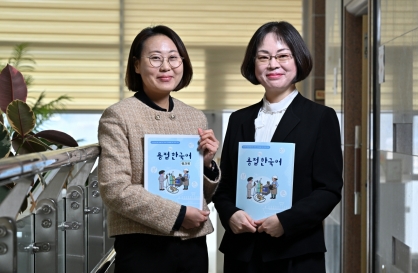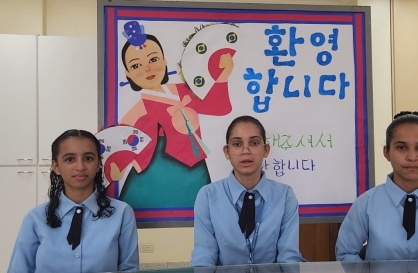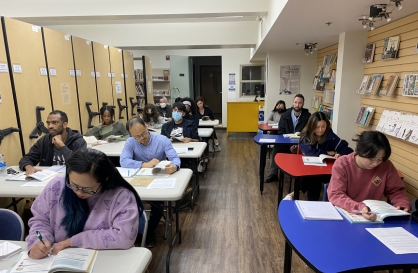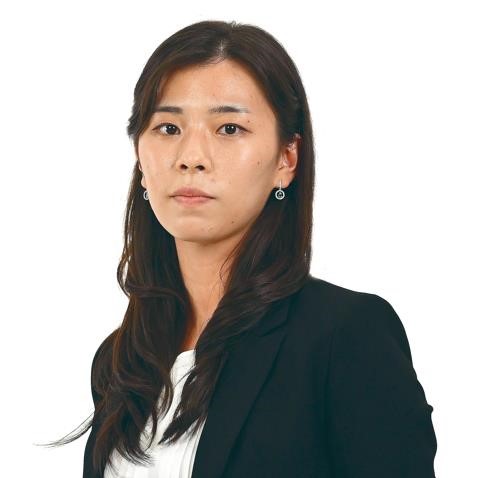Most Popular
Hello Hangeul
-
1
Welding book first in vocational Korean series for foreign labor

-
2
[Korea Beyond Korea] In Sao Paulo, horizons expand for Korean studies
![[Korea Beyond Korea] In Sao Paulo, horizons expand for Korean studies](//res.heraldm.com/phpwas/restmb_idxmake.php?idx=644&simg=/content/image/2023/11/20/20231120000619_0.jpg&u=20231206104853)
-
3
In Brasilia, worldly dreams are born from Korean classes

-
4
Americans seeking to visit Korea learn the language in LA

-
5
[Korea Beyond Korea] Berlin, Europe's Korean Studies hub, nurtures next-gen experts, scholars
![[Korea Beyond Korea] Berlin, Europe's Korean Studies hub, nurtures next-gen experts, scholars](//res.heraldm.com/phpwas/restmb_idxmake.php?idx=644&simg=/content/image/2023/10/18/20231018000929_0.jpg&u=20231023154735)
[Hello Hangeul] Hangeul adds premium feel to Korean brands
After decades of English names, retailers put spotlight on Hangeul as key marketing strategy
By Lee Yoon-seoPublished : May 29, 2023 - 15:48

On the heels of the ever-booming K-wave, Hangeul, the Korean alphabet, is being increasingly employed by both domestic and overseas companies as a unique marketing strategy to promote corporate values and raise brand awareness.
Korean food companies seeking to foray into overseas markets are making full use of Hangeul to give themselves credibility and capitalize on the special currency the Korean alphabet holds in the global market.
CJ CheilJedang, a Korean food giant whose global food sales account for 46 percent of the company's total sales, recently changed the name of its flagship Bibigo dumpling products sold overseas from gyoja to mandu. Gyoja is the Korean reading of the Chinese word for dumplings, while mandu is the Korean term for dumplings.
"The decision to change the name of the products (on the global stage) came ... as we wanted to emphasize the fact that our products are authentic K-food," said an official from CJ CheilJedang. He noted that in overseas markets, especially in Southeast Asian countries, product names in Hangeul have a more premium feel.
"Korean names have a certain merit to them, as 'Made in Korea' is largely sought after (by global consumers)," he said.
CJ CheilJedang is just one of many Korean companies releasing their products overseas with their names proudly written in Hangeul.
Nongshim, the country’s leading instant noodle maker, has been exporting its flagship products since 1971 under Koreanized names such as Shin Ramen, Neoguri and Chapagetti.
"Considering that our company's philosophy centers around the phrase 'the most Korean thing is the most global thing,’ we wanted our brand products to be recognized as the same as the goods sold in Korea (with the names in Korean)," said a Nongshim official. He added that branding its export products in Hangeul helped increase the products' overall reliability.
He admitted that in the earlier days of the company’s overseas business, Hangeul product names were generally received as “difficult” by global consumers.
"However, as global consumers' interest in Korean culture such as K-food and K-pop increased over time, consumers who were initially uncomfortable with the product names are now accepting the names of our products as proper nouns," he said, adding that the Hangeul names played a crucial role in helping Nongshim develop its brand image in overseas markets.
HiteJinro, the nation's dominant soju and beer seller, also said they are adopting the marketing tactic by selling all their products abroad under the name Jinro.
"Our brand product names such as Chamisul and Ilpum Jinro are not easy for global customers to memorize," said a HiteJinro official. However, he said that the company has long recognized the benefits of sticking true to the products' Hangeul names on the global stage because the names emphasize the originality of soju as a Korean alcohol.
“With Korean names like Chamisul and Jinro, we also can boost our originality both in brand and product quality in international markets,” he said, adding that there are even some imitation soju products sold in Southeast Asia due to their growing popularity.
Of course, the tactic of using Hangeul for marketing products is not limited to food companies.
Fashion companies have also adopted Hangeul-inspired designs to enhance their products.
Musinsa, the largest online fashion platform in Korea by sales, released a limited collaboration with its brands under the theme of Hangeul, with its products featuring brand logos and signature graphics using the Korean alphabet.
"There are many products in the fashion industry that use English logos or characteristic texts as designs, and we wanted to promote the typographic beauty that Hangeul can express," said a Musinsa official.

Multinational retailers have also shown interest in using Hangeul as a part of their collections.
In January, Italian luxury fashion house Gucci exclusively released products featuring Hangeul ahead of Lunar New Year. Among the 46 products unveiled were T-shirts and sweatshirts printed with the Gucci name written in Hangeul. The most expensive product among the Hangeul-inspired collection was a zip-up hoodie worth 3.2 million won ($2,413).
The renewed spotlight on Hangeul across different industries comes after most Korean companies, heavily dependent on exports, sought to raise their brand awareness in overseas markets by increasingly adopting English or foreign languages as part of their marketing strategy.
Lee Young-ae, a consumer science professor at Incheon University, said the prevalence of brands and product names in foreign languages has also created a social sentiment viewing goods with foreign language names as being of higher quality than goods with Korean names.
“This phenomenon took place because of the halo effect English names create. Korean consumers had long been exposed to internationally famous products whose logos were in English. When products’ names are written in Korean, consumers are not aware of the halo effect of such brand power. This is why there are more foreign languages used in trademarks and brand names,” she said.
However, Kim Ji-hyung, a Korean studies professor at Kyung Hee Cyber University, noted that Hangeul -- on top of its power to prove the originality of products and increase the goods' credibility overseas -- has commercial advantages.
He noted that Hangeul also possesses excellent design potential, and the concept has great feasibility to be transformed into various patterns and monograms.
"Hangeul consists of three parts: an initial consonant, a vowel and a consonant placed under the vowel. The possibility of the three parts' combination is greater than that of the English alphabet. Hangeul's combination of these three parts results in a formative beauty, and they may function as great tools for design," said Kim.
"Consumers who are used to foreign words might resist it at first, but the whole retail industry, led by major companies, needs to lean more towards using Hangeul names for its trademarks and brand names as much as possible.”





![[Herald Interview] How Gopizza got big in India](http://res.heraldm.com/phpwas/restmb_idxmake.php?idx=644&simg=/content/image/2024/11/20/20241120050057_0.jpg&u=20241120164556)

![[KH Explains] Dissecting Hyundai Motor's lobbying in US](http://res.heraldm.com/phpwas/restmb_idxmake.php?idx=644&simg=/content/image/2024/11/20/20241120050034_0.jpg&u=)

![[Kim Seong-kon] Farewell to the vanishing John Wayne era](http://res.heraldm.com/phpwas/restmb_idxmake.php?idx=644&simg=/content/image/2024/11/19/20241119050096_0.jpg&u=)
![[Graphic News] 70% of S. Koreans believe couples can live together without tying the knot: survey](http://res.heraldm.com/phpwas/restmb_idxmake.php?idx=644&simg=/content/image/2024/11/19/20241119050098_0.gif&u=)

![[Korea Beyond Korea] In Sao Paulo, horizons expand for Korean studies](http://res.heraldm.com/phpwas/restmb_idxmake.php?idx=644&simg=/content/image/2023/11/20/20231120000619_0.jpg&u=20231206104853)


![[Korea Beyond Korea] Berlin, Europe's Korean Studies hub, nurtures next-gen experts, scholars](http://res.heraldm.com/phpwas/restmb_idxmake.php?idx=644&simg=/content/image/2023/10/18/20231018000929_0.jpg&u=20231023154735)







![[Today’s K-pop] Blackpink’s Jennie, Lisa invited to Coachella as solo acts](http://res.heraldm.com/phpwas/restmb_idxmake.php?idx=642&simg=/content/image/2024/11/21/20241121050099_0.jpg&u=20241121172748)